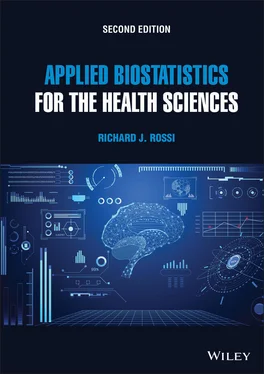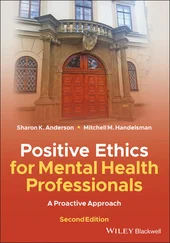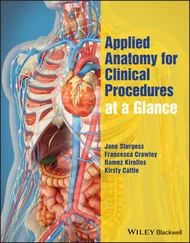Richard J. Rossi - Applied Biostatistics for the Health Sciences
Здесь есть возможность читать онлайн «Richard J. Rossi - Applied Biostatistics for the Health Sciences» — ознакомительный отрывок электронной книги совершенно бесплатно, а после прочтения отрывка купить полную версию. В некоторых случаях можно слушать аудио, скачать через торрент в формате fb2 и присутствует краткое содержание. Жанр: unrecognised, на английском языке. Описание произведения, (предисловие) а так же отзывы посетителей доступны на портале библиотеки ЛибКат.
- Название:Applied Biostatistics for the Health Sciences
- Автор:
- Жанр:
- Год:неизвестен
- ISBN:нет данных
- Рейтинг книги:3 / 5. Голосов: 1
-
Избранное:Добавить в избранное
- Отзывы:
-
Ваша оценка:
- 60
- 1
- 2
- 3
- 4
- 5
Applied Biostatistics for the Health Sciences: краткое содержание, описание и аннотация
Предлагаем к чтению аннотацию, описание, краткое содержание или предисловие (зависит от того, что написал сам автор книги «Applied Biostatistics for the Health Sciences»). Если вы не нашли необходимую информацию о книге — напишите в комментариях, мы постараемся отыскать её.
APPLIED BIOSTATISTICS FOR THE HEALTH SCIENCES Applied Biostatistics for the Health Sciences
Applied Biostatistics for the Health Sciences
Applied Biostatistics for the Health Sciences — читать онлайн ознакомительный отрывок
Ниже представлен текст книги, разбитый по страницам. Система сохранения места последней прочитанной страницы, позволяет с удобством читать онлайн бесплатно книгу «Applied Biostatistics for the Health Sciences», без необходимости каждый раз заново искать на чём Вы остановились. Поставьте закладку, и сможете в любой момент перейти на страницу, на которой закончили чтение.
Интервал:
Закладка:
Acknowledgments
I would like to thank the following statisticians who motivated me to write this book: Ray Carroll, David Ruppert, Jay Devore, Roxy Peck, Fred Ramsey, Dan Schafer, and Chip Todd. I would also like to thank Lloyd Gavin and H. Dan Brunk, two very inspirational advisors from whom I learned so much, my editors Susanne Steitz-Filler, Kimberly Monroe-Hill, and Christy Michael for their help and guidance, and my family and friends for their support in this endeavor.
R. J. Rossi
Butte, Montana
CHAPTER 1 INTRODUCTION TO BIOSTATISTICS
PRIOR TOthe twentieth century, medical research was primarily based on trial and error and empirical evidence. Diseases and the risk factors associated with a disease were not well understood. Drugs and treatments for treating diseases were generally untested. The rapid scientific breakthroughs and technological advances that took place in the latter half of the twentieth century have provided the modern tools and methods that are now being used in the study of the causes of diseases, the development and testing of new drugs and treatments, and the study of human genetics and have been instrumental in eradicating some infectious diseases.
Modern biomedical research is evidence-based research that relies on the scientific method, and in many biomedical studies it is the scientific method that guides the formulation of well-defined research hypotheses, the collection of data through experiments and observation, and the honest analysis whether the observed data support the research hypotheses. When the data in a biomedical study support a research hypothesis, the research hypothesis becomes a theory; however, when data do not support a research hypothesis, new hypotheses are generally developed and tested. Furthermore, because statistics is the science of collecting, analyzing, and interpreting data, statistics plays a very important role in medical research today. In fact, one of the fastest growing areas of statistical research is the development of specialized data collection and analysis methods for biomedical and healthcare data. The science of collecting, analyzing, and interpreting biomedical and healthcare data is called biostatistics .
1.1 What is Biostatistics?
Biostatistics is the area of statistics that covers and provides the specialized methodology for collecting and analyzing biomedical and healthcare data. In general, the purpose of using biostatistics is to gather data that can be used to provide honest information about unanswered biomedical questions. In particular, biostatistics is used to differentiate between chance occurrences and possible causal associations, for identifying and estimating the effects of risk factors, for identifying the causes or predispositions related to diseases, for estimating the incidence and prevalence of diseases, for testing and evaluating the efficacy of new drugs or treatments, and for exploring and describing the well being of the general public.
A biostatistician is a scientist trained in statistics who also works in disciplines related to medical research and public health, who designs data collection procedures, analyzes data, interprets data analyses, and helps summarize the results of the studies. Biostatisticians may also develop and apply new statistical methodology required for analyzing biomedical data. Generally, a biostatistician works with a team of medical researchers and is responsible for designing the statistical protocol to be used in a study.
Biostatisticians commonly participate in research in the biomedical fields such as epidemiology, toxicology, nutrition, and genetics, and also often work for pharmaceutical companies. In fact, biostatisticians are widely employed in government agencies such as the National Institutes of Health (NIH), the Centers for Disease Control and Prevention (CDC), the Food and Drug Administration (FDA), and the Environmental Protection Agency (EPA). Biostatisticians are also employed by pharmaceutical companies, medical research units such as the MAYO Clinic and Fred Hutchison Cancer Research Center, Sloan-Kettering Institute, and many research universities. Furthermore, some biostatisticians serve on the editorial boards of medical journals and many serve as referees for biomedical journal articles in an effort to ensure the quality and integrity of data-based biomedical results that are published.
1.2 Populations, Samples, and Statistics
In every biomedical study there will be research questions to define the particular population that is being studied. The population that is being studied is called the target population . The target population must be a well-defined population so that it is possible to collect representative data that can be used to provide information about the answers to the research questions. Finding the actual answer to a research question requires that the entire target population be observed, which is usually impractical or impossible. Thus, because it is generally impractical to observe the entire target population, biomedical researchers will use only a subset of the population units in their research study. A subset of the population is called a sample , and a sample may provide information about the answer to a research question but cannot definitively answer the question itself. That is, complete information on the target population is required to answer the research question, and because a sample is only a subset of the target population, it can only provide information about the answer. For this reason, statistics is often referred to as “the science of describing populations in the presence of uncertainty.”
The first thing a biostatistician generally must do is to take the research question and determine a particular set of characteristics of the target population that are related to the research question being studied. A biostatistician then must determine the relevant statistical questions about these population characteristics that will provide answers or the best information about the research questions. A characteristic of the target population that can be summarized numerically is called a parameter . For example, in a study of the body mass index (BMI) of teenagers, the average BMI value for the target population is a parameter, as is the percentage of teenagers having a BMI value less than 25. The parameters of the target population are based on the information about the entire population, and hence, their values will be unknown to the researcher.
To have a meaningful statistical analysis, a researcher must have well-defined research questions, a well-defined target population, a well-designed sampling plan, and an observed sample that is representative of the target population. When the sample is representative of the target population, the resulting statistical analysis will provide useful information about the research questions; however, when the observed sample is not representative of the target population the resulting statistical analysis will often lead to misleading or incorrect inferences being drawn about the target population, and hence, about the research questions, also. Thus, one of the goals of a biostatistician is to obtain a sample that is representative of the target population for estimating or testing the unknown parameters.
Once a representative sample is obtained, any quantity computed from the information in the sample and known values is called statistic . Thus, because any estimate of the unknown parameters will be based only on the information in the sample, the estimates are also statistics. Statements made by extrapolating from the sample information (i.e., statistics) about the parameters of the population are called statistical inferences , and good statistical inferences will be based on sound statistical and scientific reasoning. Thus, the statistical methods used by a biostatistician for making inferences need to be based on sound statistical and scientific reasoning. Furthermore, statistical inferences are meaningful only when they are based on data that are truly representative of the target population. Statistics that are computed from a sample are often used for estimating the unknown values of the parameters of interest, for testing claims about the unknown parameters, and for modeling the unknown parameters.
Читать дальшеИнтервал:
Закладка:
Похожие книги на «Applied Biostatistics for the Health Sciences»
Представляем Вашему вниманию похожие книги на «Applied Biostatistics for the Health Sciences» списком для выбора. Мы отобрали схожую по названию и смыслу литературу в надежде предоставить читателям больше вариантов отыскать новые, интересные, ещё непрочитанные произведения.
Обсуждение, отзывы о книге «Applied Biostatistics for the Health Sciences» и просто собственные мнения читателей. Оставьте ваши комментарии, напишите, что Вы думаете о произведении, его смысле или главных героях. Укажите что конкретно понравилось, а что нет, и почему Вы так считаете.












